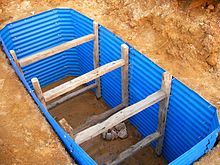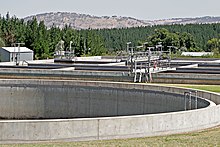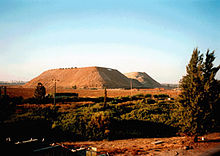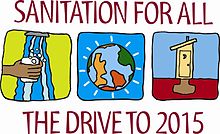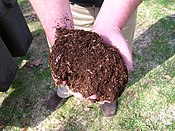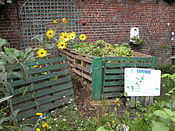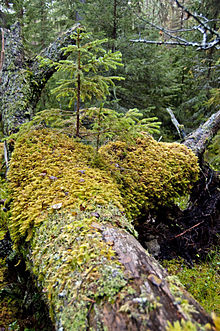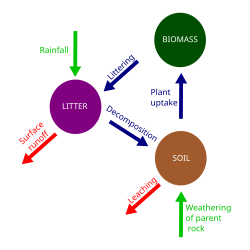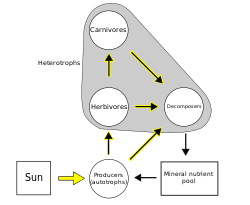The sanitation system: collection, transport, treatment, disposal or reuse.
Sanitation refers to public health conditions related to clean drinking water and adequate treatment and disposal of human wastes and sewage. Preventing human contact with feces is part of sanitation, as is hand washing with soap. Sanitation systems aim to protect human health by providing a clean environment that will stop the transmission of disease, especially through the fecal–oral route. For example, diarrhea, a main cause of malnutrition and stunted growth in children, can be reduced through sanitation. There are many other diseases which are easily transmitted in communities that have low levels of sanitation, such as ascariasis (a type of intestinal worm infection or helminthiasis), cholera, hepatitis, polio, schistosomiasis, trachoma, to name just a few.
A range of sanitation technologies and approaches exists. Some examples are community-led total sanitation, container-based sanitation, ecological sanitation, emergency sanitation, environmental sanitation, onsite sanitation and sustainable sanitation. A sanitation system includes the capture, storage, transport, treatment and disposal or reuse of human excreta and wastewater.
Reuse activities within the sanitation system may focus on the
nutrients, water, energy or organic matter contained in excreta and
wastewater. This is referred to as the "sanitation value chain" or
"sanitation economy".
Several sanitation "levels" are being used to compare sanitation service levels within countries or across countries. The sanitation ladder defined by the Joint Monitoring Programme in 2016 starts at open defecation and moves upwards using the terms "unimproved", "limited", "basic", with the highest level being "safely managed". This is particularly applicable to developing countries.
The Human Right to Water and Sanitation was recognized by the United Nations (UN) General Assembly in 2010. Sanitation is a global development priority and the subject of Sustainable Development Goal 6. The estimate in 2017 by JMP states that 4.5 billion people currently do not have safely managed sanitation. Lack of access to sanitation has an impact not only on public health but also on human dignity and personal safety.
Definition
The World Health Organization defines the term "sanitation" as follows:
"Sanitation generally refers to the provision of facilities and services for the safe disposal of human urine and feces. The word 'sanitation' also refers to the maintenance of hygienic conditions, through services such as garbage collection and wastewater disposal."
Sanitation includes all four of these engineering infrastructure
items (even though often only the first one is strongly associated with
the term "sanitation"): Excreta management systems, wastewater
management systems (included here are wastewater treatment plants), solid waste management systems, drainage systems for rainwater, also called stormwater drainage.
There are some variations on the use of the term "sanitation" between countries. For example, hygiene promotion is seen by some as an integral part of sanitation. For this reason, the Water Supply and Sanitation Collaborative Council defines sanitation as "The collection, transport, treatment and disposal or reuse of human excreta, domestic wastewater and solid waste, and associated hygiene promotion."
Despite the fact that sanitation includes wastewater treatment,
the two terms are often used side by side as "sanitation and wastewater
management".
Purposes
The
overall purposes of sanitation are to provide a healthy living
environment for everyone, to protect the natural resources (such as surface water, groundwater, soil), and to provide safety, security and dignity for people when they defecate or urinate.
The Human Right to Water and Sanitation was recognized by the United Nations (UN) General Assembly in 2010. It has been recognized in international law through human rights treaties, declarations and other standards. It is derived from the human right to an adequate standard of living.
Effective sanitation systems provide barriers between excreta and humans in such a way as to break the disease transmission cycle (for example in the case of fecal-borne diseases). This aspect is visualised with the F-diagram where all major routes of fecal-oral disease transmission begin with the letter F: feces, fingers, flies, fields, fluids, food.
One of the main challenges is to provide sustainable sanitation, especially in developing countries.
Maintaining and sustaining sanitation has aspects that are
technological, institutional and social in nature. Sanitation
infrastructure has to be adapted to several specific contexts including
consumers' expectations and local resources available.
Sanitation technologies may involve centralized civil engineering structures like sewer systems, sewage treatment, surface runoff treatment and solid waste landfills. These structures are designed to treat wastewater and municipal solid waste.
Sanitation technologies may also take the form of relatively simple
onsite sanitation systems. This can in some cases consist of a simple pit latrine or other type of non-flush toilet for the excreta management part.
Providing sanitation to people requires attention to the entire system, not just focusing on technical aspects such as the toilet, fecal sludge management or the wastewater treatment plant.
The "sanitation chain" involves the experience of the user, excreta and
wastewater collection methods, transporting and treatment of waste, and
reuse or disposal. All need to be thoroughly considered.
Types and terms
Percentage of population served by different types of sanitation systems
Example of sanitation infrastructure: Shower, double-vault urine-diverting dry toilet (UDDT) and waterless urinal in Lima, Peru
The term sanitation is connected with various descriptors or
adjectives to signify certain types of sanitation systems (which may
deal only with human excreta
management or with the entire sanitation system, i.e. also greywater,
stormwater and solid waste management) – in alphabetical order:
Basic sanitation
In 2017, JMP defined a new term: "basic sanitation service". This is defined as the use of improved sanitation
facilities that are not shared with other households. A lower level of
service is now called "limited sanitation service" which refers to use
of improved sanitation facilities that are shared between two or more
households.
Container-based sanitation
Container-based sanitation (CBS) refers to a sanitation system where human excreta is collected in sealable, removable containers (or cartridges) that are transported to treatment facilities. Container-based sanitation is usually provided as a service involving provision of certain types of portable toilets,
and collection of excreta at a cost borne by the users. With suitable
development, support and functioning partnerships, CBS can be used to
provide low-income urban populations with safe collection, transport and
treatment of excrement at a lower cost than installing and maintaining sewers. In most cases, CBS is based on the use of urine-diverting dry toilets.
Community-led total sanitation
Community-Led Total Sanitation (CLTS) is an approach to achieve behavior change in mainly rural people by a process of "triggering", leading to spontaneous and long-term abandonment of open defecation
practices. CLTS takes an approach to rural sanitation that works
without hardware subsidies and that facilitates communities to recognize
the problem of open defecation and take collective action to clean up and become "open defecation free".
Dry sanitation
The
term "dry sanitation" is not in widespread use and is not very well
defined. It usually refers to a system that uses a type of dry toilet and no sewers to transport excreta. Often when people speak of "dry sanitation" they mean a sanitation system that uses urine-diverting dry toilet (UDDTs).
Ecological sanitation
Ecological sanitation,
which is commonly abbreviated to ecosan, is an approach, rather than a
technology or a device which is characterized by a desire to "close the
loop" (mainly for the nutrients and organic matter) between sanitation
and agriculture in a safe manner. Put in other words: "Ecosan systems
safely recycle excreta resources (plant nutrients and organic matter) to
crop production in such a way that the use of non-renewable resources
is minimised". When properly designed and operated, ecosan systems
provide a hygienically safe, economical, and closed-loop system to
convert human excreta into nutrients to be returned to the soil, and
water to be returned to the land. Ecosan is also called
resource-oriented sanitation.
Emergency pit lining kits by Evenproducts
Emergency sanitation
Emergency sanitation is required in situations including natural disasters and relief for refugees and Internally Displaced Persons (IDPs). There are three phases: Immediate, short term and long term. In the immediate phase, the focus is on managing open defecation, and toilet technologies might include very basic latrines, pit latrines, bucket toilets, container-based toilets, chemical toilets. The short term phase might also involve technologies such as urine-diverting dry toilets, septic tanks, decentralized wastewater systems. Providing handwashing facilities and management of fecal sludge are also part of emergency sanitation. The Sphere Project handbook provides protection principles and core standards for sanitation to put in place after a disaster or conflict.
Environmental sanitation
Environmental sanitation encompasses the control of environmental factors that are connected to disease transmission. Subsets of this category are solid waste management, water and wastewater treatment, industrial waste treatment and noise and pollution control.
Improved and unimproved sanitation
Improved sanitation and unimproved sanitation
refers to the management of human feces at the household level. This
terminology is the indicator used to describe the target of the Millennium Development Goal on sanitation, by the WHO/UNICEF Joint Monitoring Programme for Water Supply and Sanitation.
Lack of sanitation
Lack
of sanitation refers to the absence of sanitation. In practical terms
it usually means lack of toilets or lack of hygienic toilets that
anybody would want to use voluntarily. The result of lack of sanitation
is usually open defecation (and open urination but this is of less concern) with associated serious public health issues. It is estimated that 2.4 billion people still lacked improved sanitation facilities as of 2015.
Onsite sanitation
Onsite
sanitation (or on-site sanitation) is defined as "a sanitation system
in which excreta and wastewater are collected and stored or treated on
the plot where they are generated". The degree of treatment may be variable, from none to advanced. Examples are pit latrines (no treatment) and septic tanks (primary treatment of wastewater). On-site sanitation systems are often connected to fecal sludge management systems where the fecal sludge that is generated onsite is treated at an offsite location. Wastewater (sewage) is only generated when piped water supply is available within the buildings or close to them.
A related term is a decentralized wastewater system which refers in particular to the wastewater part of on-site sanitation. Similarly, an onsite sewage facility can treat the wastewater generated locally.
Safely managed sanitation
A relatively high level of sanitation service is now called "safely managed sanitation" by the JMP
definition. This is basic sanitation service where in addition excreta
are safely disposed of in situ or transported and treated offsite.
Sustainable sanitation
Sustainable sanitation considers the entire "sanitation value chain", from the experience of the user, excreta and wastewater collection methods, transportation or conveyance of waste, treatment, and reuse or disposal. The term is widely used since about 2009. In 2007 the Sustainable Sanitation Alliance
defined five sustainability criteria to compare the sustainability of
sanitation systems. In order to be sustainable, a sanitation system has
to be economically viable, socially acceptable, technically and
institutionally appropriate, and it should also protect the environment
and the natural resources.
Other
Other terms used to describe certain types of sanitation include:
- Community-based sanitation (often related to decentralized wastewater treatment or DEWATS)
Health aspects
The "F-diagram" (feces, fingers, flies, fields, fluids, food), showing pathways of fecal-oral disease transmission. The vertical blue lines show barriers: toilets, safe water, hygiene and handwashing.
For any social and economic development, adequate sanitation in
conjunction with good hygiene and safe water are essential to good
health. Lack of proper sanitation causes diseases. Most of the diseases
resulting from sanitation have a direct relation to poverty. The lack of
clean water and poor sanitation causes many diseases and the spread of
diseases. It is estimated that inadequate sanitation is responsible for
4.0 percent of deaths and 5.7 percent of disease burden worldwide.
Lack of sanitation is a serious issue that is affecting most
developing countries and countries in transition. The importance of the
isolation of excreta and waste lies in an effort to prevent diseases
which can be transmitted through human waste, which afflict both developed countries as well as developing countries to differing degrees.
This situation presents substantial public health risks as the waste could contaminate drinking water and cause life-threatening forms of diarrhea to infants. Improved sanitation, including hand washing and water purification, could save the lives of 1.5 million children who die from diarrheal diseases each year.
It is estimated that up to 5 million people die each year from preventable waterborne diseases,
as a result of inadequate sanitation and hygiene practices. The effects
of sanitation has impacted the society of people throughout history. Sanitation is a necessity for a healthy life.
Diarrhea
Diarrhea plays a significant role: Deaths resulting from diarrhea are
estimated to be between 1.6 and 2.5 million deaths every year. Most of the affected are young children below the ages of five. Children suffering from diarrhea are more vulnerable to become underweight (due to stunted growth) which makes them more vulnerable to other diseases such as acute respiratory infections and malaria. Diarrhoea is primarily transmitted through faecal-oral routes.
Numerous studies have shown that improvements in drinking water and sanitation (WASH) lead to decreased risks of diarrhoea. Such improvements might include for example use of water filters, provision of high-quality piped water and sewer connections.
Open defecation – or lack of sanitation – is a major factor in causing various diseases, most notably diarrhea and intestinal worm infections.
For example, infectious diarrhea resulted in about 0.7 million deaths
in children under five years old in 2011 and 250 million lost school
days. It can also lead to malnutrition and stunted growth
in children. Open defecation is a leading cause of diarrheal death;
2,000 children under the age of five die every day, one every 40
seconds, from diarrhea.
Malnutrition and stunting
A child receiving malnutrition treatment in Northern Kenya
The combination of direct and indirect deaths from malnutrition
caused by unsafe water, sanitation and hygiene (WASH) practices is
estimated by the World Health Organisation to lead to 860,000 deaths per
year in children under five years of age. The multiple
interdependencies between malnutrition and infectious diseases make it
very difficult to quantify the portion of malnutrition that is caused by
infectious diseases which are in turn caused by unsafe WASH practices.
Based on expert opinions and a literature survey, researchers at WHO
arrived at the conclusion that approximately half of all cases of
malnutrition (which often leads to stunting) in children under five is
associated with repeated diarrhoea or intestinal worm infections as a
result of unsafe water, inadequate sanitation or insufficient hygiene.
Diseases caused by lack of sanitation
Relevant diseases and conditions caused by lack of sanitation and hygiene include:
- Waterborne diseases, which can contaminate drinking water
- Diseases transmitted by the fecal-oral route
- Infections with intestinal helminths (worms) - approximately two billion people are infected with soil-transmitted helminths worldwide; they are transmitted by eggs present in human faeces which in turn contaminate soil in areas where sanitation is poor.
- Stunted growth in children
- Malnutrition, particularly in children
The list of diseases that could be reduced with proper access to
sanitation and hygiene practices is very long. For example, in India, 15
diseases have been listed which could be stamped out by improving
sanitation:
- Anaemia, malnutrition
- Ascariasis (a type of intestinal worm infection)
- Campylobacteriosis
- Cholera
- Cyanobacteria toxins
- Dengue
- Hepatitis
- Japanese encephalitis (JE)
- Leptospirosis
- Malaria
- Ringworm or Tinea (actually a fungal infection)
- Scabies
- Schistosomiasis
- Trachoma
- Typhoid and paratyphoid enteric fevers
- Shigellosis
Polio is another disease which is related to improper sanitation and hygiene.
Hygiene promotion
Hygiene education (on proper handwashing) in Afghanistan
In many settings, provision of sanitation facilities alone does not
guarantee good health of the population. Studies have suggested that the
impact of hygiene practices have as great an impact on sanitation
related diseases as the actual provision of sanitation facilities.
Hygiene promotion is therefore an important part of sanitation and is
usually key in maintaining good health.
Hygiene promotion is a planned approach of enabling people to act
and change their behaviour in an order to reduce and/or prevent
incidences of water, sanitation and hygiene (WASH)
related diseases. It usually involves a participatory approach of
engaging people to take responsibility of WASH services and
infrastructure including its operation and maintenance. The three key
elements of promoting hygiene are; mutual sharing of information and
knowledge, the mobilisation of affected communities and the provision of
essential material and facilities.
Environmental aspects
Indicator organisms
When analysing environmental samples, various types of indicator organisms are used to check for fecal pollution of the sample. Commonly used indicators for bacteriological water analysis include the bacterium Escherichia coli (abbreviated as E. coli) and non-specific fecal coliforms. With regards to samples of soil, sewage sludge, biosolids or fecal matter from dry toilets, helminth
eggs are a commonly used indicator. With helminth egg analysis, eggs
are extracted from the sample after which a viability test is done to
distinguish between viable and non viable eggs. The viable fraction of
the helminth eggs in the sample is then counted.
Wastewater and stormwater management
Sewage treatment plant, Australia.
Wastewater management consists of collection, wastewater treatment (be it municipal or industrial wastewater), disposal or reuse of treated wastewater. The latter is also referred to as water reclamation.
Sanitation systems in urban areas of developed countries usually consist of the collection of wastewater in gravity driven sewers, its treatment in wastewater treatment plants for reuse or disposal in rivers, lakes or the sea. Sewers are either combined with storm drains or separated from them as sanitary sewers. Combined sewers are usually found in the central, older parts or urban areas. Heavy rainfall and inadequate maintenance can lead to combined sewer overflows or sanitary sewer overflows, i.e., more or less diluted raw sewage
being discharged into the environment. Industries often discharge
wastewater into municipal sewers, which can complicate wastewater
treatment unless industries pre-treat their discharges.
In developing countries most wastewater is still discharged untreated into the environment. Alternatives to centralized sewer systems include onsite sanitation, decentralized wastewater systems, dry toilets connected to fecal sludge management.
Solid waste disposal
Disposal of solid waste is most commonly conducted in landfills, but incineration, recycling, composting and conversion to biofuels are also avenues. In the case of landfills, advanced countries typically have rigid protocols for daily cover with topsoil, where underdeveloped countries customarily rely upon less stringent protocols. The importance of daily cover lies in the reduction of vector contact and spreading of pathogens.
Daily cover also minimises odor emissions and reduces windblown litter.
Likewise, developed countries typically have requirements for perimeter
sealing of the landfill with clay-type soils to minimize migration of leachate that could contaminate groundwater (and hence jeopardize some drinking water supplies).
For incineration options, the release of air pollutants, including certain toxic components is an attendant adverse outcome. Recycling and biofuel conversion are the sustainable options that generally have superior lifecycle costs, particularly when total ecological consequences are considered. Composting value will ultimately be limited by the market demand for compost product.
Other industries
Food industry
Modern restaurant food preparation area.
Sanitation within the food industry means the adequate treatment of
food-contact surfaces by a process that is effective in destroying
vegetative cells of microorganisms of public health
significance, and in substantially reducing numbers of other
undesirable microorganisms, but without adversely affecting the food or
its safety for the consumer (U.S. Food and Drug Administration, Code of Federal Regulations, 21CFR110, USA). Sanitation Standard Operating Procedures are mandatory for food industries in United States. Similarly, in Japan, food hygiene has to be achieved through compliance with food sanitation law.
In the food and biopharmaceutical industries, the term "sanitary equipment" means equipment that is fully cleanable using clean-in-place (CIP) and sterilization-in-place (SIP) procedures: that is fully drainable from cleaning solutions and other liquids. The design should have a minimum amount of deadleg, or areas where the turbulence during cleaning is insufficient to remove product deposits. In general, to improve cleanability, this equipment is made from Stainless Steel 316L, (an alloy containing small amounts of molybdenum). The surface is usually electropolished to an effective surface roughness of less than 0.5 micrometre to reduce the possibility of bacterial adhesion.
Developing countries
Modified logo of International Year of Sanitation, used in the UN Drive to 2015 campaign logo
In December 2006, the United Nations General Assembly declared 2008 "The International Year of Sanitation", in recognition of the slow progress being made towards the MDGs sanitation target. The year aimed to develop awareness and more actions to meet the target.
Sustainable Development Goal Number 6 (from 2016 onwards)
In the year 2016, the Sustainable Development Goals replaced the Millennium Development Goals. Sanitation is a global development priority and the subject of Sustainable Development Goal 6 (SDG 6). The target is to ensure everyone everywhere has access to toilets by 2030.
One indicator for the sanitation target is the "Proportion of
population using safely managed sanitation services, including a
hand-washing facility with soap and water". The current value in the 2017 baseline estimate by JMP is that 4.5 billion people currently do not have safely managed sanitation. JMP is the Joint Monitoring Programme by UNICEF and WHO to monitor SDG6 progress.
Millennium Development Goal Number 7 until 2015
Example for lack of sanitation: Unhygienic pit latrine with ring slab in Kalibari community in Mymensingh, Bangladesh
The United Nations, during the Millennium Summit in New York in 2000 and the 2002 World Summit on Sustainable Development in Johannesburg, developed the Millennium Development Goals
(MDGs) aimed at poverty eradication and sustainable development. The
specific goal for the year 2015 was to reduce by half the number of
people who had no access to potable water and sanitation in the baseline year of 1990. As the JMP and the United Nations Development Programme
(UNDP) Human Development Report in 2006 has shown, progress meeting the
MDG sanitation target is slow, with a large gap between the target
coverage and the current reality.
There are numerous reasons for this gap. A major one is that
sanitation is rarely given political attention received by other topics
despite its key importance. Sanitation is not high on the international
development agenda, and projects such as those relating to water supply projects are emphasised.
The Joint Monitoring Programme for Water Supply and Sanitation of WHO and UNICEF
(JMP) has been publishing reports of updated estimates every two years
on the use of various types of drinking-water sources and sanitation
facilities at the national, regional and global levels. The JMP report
for 2015 stated that:
- Between 1990 and 2015, open defecation rates have decreased from 38% to 25% globally. Just under one billion people (946 million) still practise open defecation worldwide in 2015.
- 82% of the global urban population, and 51% of the rural population is using improved sanitation facilities in 2015, as per the JMP definition of "improved sanitation".
Economic benefits
The
benefits to society of managing human excreta are considerable, for
public health as well as for the environment. For every US$1 spent on
sanitation, the estimated return to society is US$5.50.
Various initiatives
In 2011 the Bill & Melinda Gates Foundation
launched the Reinvent the Toilet Challenge to promote safer, more
effective ways to treat human waste. The program is aimed at developing
technologies that might help bridge the global sanitation gap.
The treatment components of the Nano Membrane Toilet from the BMGF "Reinvent the toilet challenge"
History
Major human settlements could initially develop only where fresh surface water was plentiful, such as near rivers or natural springs.
Throughout history people have devised systems to get water into their
communities and households, and to dispose (and later also treat)
wastewater. The focus of sewage treatment at that time was on conveying raw sewage to a natural body of water, e.g. a river or ocean, where it would be diluted and dissipated.
The Sanitation in the Indus Valley Civilization in Asia is an example of public water supply and sanitation during the Bronze Age (3300–1300 BCE).
Sanitation in ancient Rome was quite extensive. These systems consisted of stone and wooden drains to collect and remove wastewater from populated areas—see for instance the Cloaca Maxima into the River Tiber in Rome. It is estimated that the first sewers of ancient Rome were built between 800 and 735 BCE. Nevertheless, there was widespread presence of several helminth types (intestinal worms) that caused dysentery.
There is little record of other sanitation in most of Europe until the High Middle Ages. Unsanitary conditions and overcrowding were widespread throughout Europe and Asia during the Middle Ages. This resulted in pandemics such as the Plague of Justinian (541–542) and the Black Death (1347–1351), which killed tens of millions of people. Very high infant and child mortality prevailed in Europe throughout medieval times, due partly to deficiencies in sanitation.
Modern history
The
modern technology has improved sanitation greatly. Research has done to
reuse human waste. In space, astronauts recycle their urine, because of
the limited supplies on the International Space Station.



